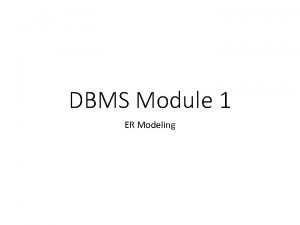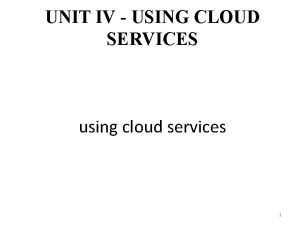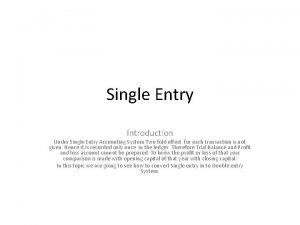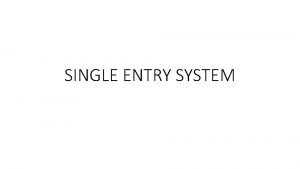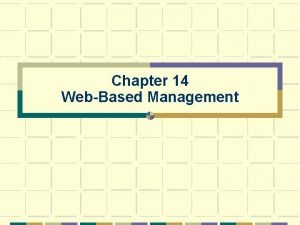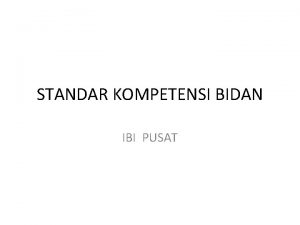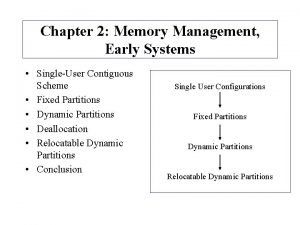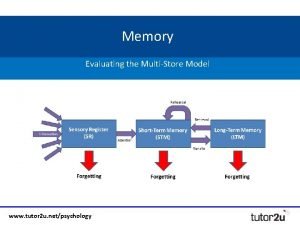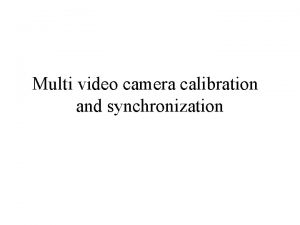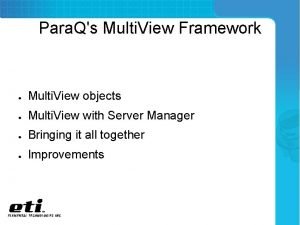Task Management An Introduction to Single and Multi







































- Slides: 39

Task Management: An Introduction to Single and Multi Patient Task Lists June 2013

How to Use this Tutorial Welcome to the Power. Chart Millennium Task Management tutorial. This tutorial will give you general knowledge and understanding of how to use Task Lists in e. Ki. Ds Power. Chart. Introduction to Task Lists 2

Course Objectives Upon completion of this course, you will be able to: Introduction to Task Lists l Understand Task List Functionality l Illustrate the Components of Task Lists l Complete / Chart Assigned Tasks l Customize Task Lists l Troubleshoot common errors in Task Management 3

Task Management Course Contents Lesson 1: Components of Task Lists Lesson 2: Customizing Task Lists to Display Tasks Lesson 3: Charting in Task Lists Lesson 4: Miscellaneous Task List Actions Lesson 5: Troubleshooting Common Errors / System Messages in Task Lists Introduction to Task Lists 4

Lesson One: Understanding Task Lists Tasks Lists are used to identify tasks that clinicians need to perform. In addition, it helps document those tasks by providing charting capability. CHKD uses e. Ki. Ds Power. Chart for Task Management. • The Single Patient Task List (SPTL), displays all tasks for a single patient. • The Multi Patient Task List (MPTL) displays tasks for several patients for a specific department and is used mainly by management. 5

Lesson One: Understanding Task Lists – SPTL The Single-Patient Task List is found by opening a patient’s chart and selecting the Task List tab. It lists all tasks for a specific patient and displays limited additional information, such as the task status, scheduled date and time, and the details of the order associated to the task. Lesson One: Components of Task Lists 6

Lesson One: Task Assignment Procedure When an order is generated, if tasks are linked to the order they are created and displayed on the task list. Not all orders will trigger an entry on the task list. Only if an order has an associated task to be completed, will it appear on the task list. Lesson One: Components of Task Lists 7

Lesson One: Accessing SPTL The Single Patient Task List (SPTL) is accessed from within a Patient’s Chart in e. Ki. Ds Power. Chart. The Task Lists appears as a tab within the Patient’s Chart. To access the Single Patient Task List, simply click on the Task List tab from within a patient’s chart. Lesson One: Components of Task Lists 8

Lesson One: Components of Task Lists Task List Toolbar Information Bar Refresh Button Task at-a-Glance Bar Lesson One: Components of Task Lists 9

Lesson One: Components of Task Lists Task List Toolbar The Task List toolbar appears in the right hand corner of the Single Patient Task Lists. It allows you to quickly chart tasks by selecting the appropriate charting option on the toolbar. (Charting functionality will be discussed later in the CBT. ) The Charting Options available from the Task List Toolbar are shown to the right. Button Action Chart Done—Allows you to chart the task as Done. (Results are entered as Done. ) Not Done—If a task is unable to be performed, click this button. The status of the task then becomes Complete. Quick Chart—Same functionality as Chart Done. Allows you to chart the task as Done. (Results are entered as Done. ) Un-chart—If a task was started or completed accidentally, Un-chart reinitializes the task to a Pending status. Reschedule This Task—Opens the Reschedule dialog box so a task can be rescheduled. Lesson One: Components of Task Lists 10

Lesson One: Components of Task Lists Default Sub Tab within Task Lists The default sub tab within Task Lists is the Scheduled Patient Care tab. Lesson One: Components of Task Lists 11

Lesson One: Components of Task Lists Information Bar - SPTL The Information Bar in the SPTL is located above the Scheduled Patient Care subtab and displays the selected date range for tasks. The tasks that are displayed on the task list are generated from the date range in the system. If the date is inaccurate, the current tasks may not display. To change the displayed date range, a user can right-click on the Information Bar. This will be discussed later in this CBT. Lesson One: Components of Task Lists 12

Lesson One: Components of Task Lists Task-at-a-Glance Bar The Task-at-a-Glance Bar is the first untitled bar in the Single Patient Task List. The Task-at-a-Glance Bar is used to determine the status of a task or to use Chart Done functionality for a selected task. In the example above, the tasks are overdue (indicated by the Alarm Clock icon). Status Indication: To see indicator definitions, select Task-at-a-Glance Legend from the Options Menu. Charting Operation: Single Clicking the Task-at-a-Glance Bar uses the Chart Done functionality for tasks that can be completed as Chart Done. Lesson One: Components of Task Lists 13

Lesson One: Components of Task Lists Task-at-a-Glance Legend The Task-at-a-Glance Legend provides an explanation of the symbols used on the Task-at-a-Glance Bar. To access the Task-at-a-Glance Legend, select Task-at-a-Glance Legend from the Options menu. Lesson One: Components of Task Lists 14

Lesson One: Components of Task Lists Menu Bar The Menu bar in Power. Chart is located underneath the title bar. Menu options within the menu bar can be accessed by pointing and clicking on the desired selection. With the Task List open, users can select the Options menu to display task list related options. Lesson One: Components of Task Lists 15

Lesson One: Components of Task Lists Refresh Button The Refresh Button tells you the last time the information on display was refreshed or updated. In the above example, this display is 13 minutes old. You may not be aware of tasks that have been generated since you opened the Task List if you do not Refresh. By clicking the Refresh button, the Task List is refreshed and displays the latest updated information. Lesson One: Components of Task Lists 16

Lesson Two: Customizing Task Lists to Display Tasks Filters provide the ability to limit the tasks that are displayed on the task list, thereby, making the task list more manageable. Task Lists can be filtered by time (to see tasks for only one day or one shift) or by task status (to show only Pending tasks or all tasks). Filtering tasks correctly will reduce your workload because you will only see pertinent tasks for a specified time. Lesson Two: Customizing Task Lists to Display Tasks 17

Lesson Two: Customizing Task Lists to Display Tasks Using the Time Frame Filtering by Time Frame triggers all tasks within a specified time range to display in the Task List. To start filtering using the Time Frame Filter, select Task List Properties from the Options Menu. Lesson Two: Customizing Task Lists to Display Tasks 18

Lesson Two: Customizing Task Lists to Display Tasks Using the Time Frame Filter The Task List Properties window will open. Select the appropriate Time Frame. Lesson Two: Customizing Task Lists to Display Tasks 19

Lesson Two: Customizing Task Lists to Display Tasks Using the Time Frame Filter (Cont’d) Defined Time Frame A predefined time frame, such as a shift, that has been built into the database. With the defined time frame option selected, the Range selection becomes active. The Range selection allows you to view tasks for the current shift, the previous shift, or the next shift. Hour Interval A filter of only one hour’s time for the current day. When this option is selected, the Show Me My portion of the Task List Properties window becomes active, allowing you to specify a specific hour’s worth of tasks to view. Generic Time Frame A time frame to be defined by the user for unique shifts or for past task data retrieval. With the Generic Time Frame option selected, the From / To portion of the Task List Windows becomes active, allowing you to view tasks from the past or the future. Right-Clicking on the Time Frame in the Information Bar and selecting Change Time Frame Criteria will also display the Task List Properties window. Lesson Two: Customizing Task Lists to Display Tasks 20

Lesson Two: Customizing Task Lists to Display Tasks Using the Time Frame Filter (Cont’d) Click OK when finished. All tasks that meet the time frame criteria that you have specified will be displayed on your task list. By default, overdue tasks will also appear on the task list. Right-Clicking on the Time Frame in the Information Bar and selecting Change Time Frame Criteria will also display the Task List Properties window. Lesson Two: Customizing Task Lists to Display Tasks 21

Lesson Two: Customizing Task Lists to Display Tasks Using the Task Display Filter The Task Display Filter provides a means of filtering tasks by their status (Completed, Pending, etc. ) You do not have the security to change filters for Time Parameters, Medications, and Task Types in the Viewing window. These areas will remain inactive. You are able only to make changes to see the same type of tasks in different statuses. Lesson Two: Customizing Task Lists to Display Tasks To begin setting the Task Display Filter, select Task Display from the Options Menu. The Viewing window will appear (displayed on left). 22

Lesson Two: Customizing Task Lists to Display Tasks Choose the appropriate statuses of the tasks that you want to see by checking/un-checking the boxes. Click OK when complete. The system always displays tasks that have an Overdue or In Process status. These may not be de-selected. Lesson Two: Customizing Task Lists to Display Tasks 23

Lesson Two: Customizing Task Lists to Display Tasks Using the Task Display Filter (Cont’d) The updated task list will show only tasks that meet the specified statuses that you have input into the system. Lesson Two: Customizing Task Lists to Display Tasks 24

Lesson Three: Charting in Task Lists How a task is completed depends upon its type. Some tasks require additional details to be documented on a form, such as Height, Weight and Allergies, and others may require only a confirmation of completion. The system keeps track of the type of task and makes only the appropriate options available to you. (You will not have the option to Reschedule a Completed task, for example. ) Lesson Three: Charting in Task Lists 25

Lesson Three: Charting in Task Lists To chart a task in Power. Chart, start by selecting the task. (More than one task can be charted at the same time if they have the same charting method options. Right click the task and choose the appropriate charting type from the context (right-click) menu. OR Click the task and choose the appropriate charting type from the task list menu on the upper-left hand corner of the task list toolbar. Lesson Three: Charting in Task Lists 26

Lesson Three: Charting in Task Lists Charting Options Chart Done Chart Not Done Un Chart Use this selection to perform simple charting. These tasks are typically simple to-dos that do not require any added detail other than a record of being completed. Use this selection to chart a task cannot be completed and will never be completed (example: the task is not appropriate for the patient). Charting a task as ‘Not Done’ will complete the task and remove it from the schedule. You will be asked to include the reason the task was not completed. After the charting is signed, notice that the status on the Task List is Complete; however, the symbol to the left of the task indicates that the task was Not Done. Use this selection to change a task back to Pending and to “undo” the charting. This may be necessary if charting occurs on the wrong task or the wrong patient. Un-charting a task changes the status to Pending and changes the status of any associated documentation to In Error. The Un-chart option displays only when a completed task is selected. Chart Done Date / Time Lesson Three: Charting in Task Lists Use this selection to Chart the task as Done with a date and time to stamp on the results. (Results are entered as Done. ) You can also use this option to chart a task for someone else. 27

Lesson Three: Charting in Task Lists Charting Options: Chart Done Use this selection to perform simple charting. These tasks are typically simple todos that do not require any added detail other than a record of being completed. Lesson Three: Charting in Task Lists 28

Lesson Three: Charting in Task Lists When you choose to chart a task as Not Done, you must enter a reason why the task will not be done in the Reason Window. You can select a reason from the Reason Not Done drop down box, or select other in the box and type the reason in the comments field. Lesson Three: Charting in Task Lists 29

Lesson Three: Charting in Task Lists Charting Options: Unchart When you choose to Unchart a task, you must enter a reason why you are uncharting the task into the Reason Window. (Always enter Error in Documentation) This is a free text field, and once you enter a comment in the Comment field, you will be able to save (by clicking on ) and exit the window. Lesson Three: Charting in Task Lists 30

Lesson Three: Charting in Task Lists Charting Options: Chart Done Date/Time When you choose to Chart Done Date/Time, you are given the ability to chart a task that was previously done and not charted, or to chart for someone else by proxy, always following Hospital Policies Enter the date and time that the task was completed in the Date/Time field. Enter who the task was performed by in the Performed by field. When finished, click OK. Task Information will show that the charted task was completed at the date that you entered and “performed by” the person that you entered. Lesson Three: Charting in Task Lists 31

Lesson Three: Charting in Task Lists Multi Selecting Tasks for Charting More than one task can be selected and completed at the same time, as long as they have the same method for completion. In other words, if a clinician wants to complete two like tasks on a task list, he / she is able to do so. However, if the clinician wants to complete (chart) one task as done and chart a second task as not done, they cannot be charted simultaneously. Lesson Three: Charting in Task Lists 32

Lesson Three: Charting in Task Lists To complete more than one task simultaneously, click on all tasks for completion. Multi Selecting Tasks for Charting Right-click and select the appropriate charting option. (When more than one task is selected for charting, right clicking will show all available charting options for both tasks. ) If more than one task is selected and they do not have the same method of completion, all the completion options are grayed out. Lesson Three: Charting in Task Lists In the screen print above, two tasks have been selected for completion. 33

Lesson Three: Charting in Task Lists Rescheduling Tasks Occasionally a task cannot be completed at the time it was scheduled. Tasks that cannot be completed at the current time but can be completed at a later time may be rescheduled (example: the patient is unavailable at the scheduled time) Rescheduling a task will simply move it from the current schedule to the new schedule. The ability to reschedule a task is a database setting. The system allows the ability to reschedule a task for 72 hours after its scheduled date and time, but this may vary by department. For example, some tasks within the Respiratory Therapy department may need to be rescheduled sooner. Lesson Three: Charting in Task Lists 34

Lesson Three: Charting in Task Lists Rescheduling Tasks To reschedule a task, select it by clicking on it. Right click the task to display the context (rightclick) menu. Select Reschedule This Task from the menu. Lesson Three: Charting in Task Lists 35

Lesson Three: Charting in Task Lists Rescheduling Tasks The Reschedule Task dialog box will appear. Select a Reschedule date and time. Choose the applicable Rescheduling Reason from the Drop Down box. Click OK. As long as the reschedule date falls into the departmentdefined parameters, the OK button will become active and you will be able to reschedule the task. Lesson Three: Charting in Task Lists 36

Lesson Three: Charting in Task Lists The rescheduled task will appear on the task list with a status of ‘Pending’. If the rescheduled task does not appear on your task list, confirm that your Time Frame filter includes your Rescheduled date. (If you rescheduled for January 12 and you want to confirm that the task is listed on the Task List for that day, make sure that the date on your Information Bar goes to January 12. ) Lesson Three: Charting in Task Lists 37

Lesson Three: Charting in Task Lists Tips and Tricks ü If your Task Display Filter is not set to display Completed tasks, once you chart a task as complete, it will fall off of your task list. ü You can sort tasks by Name, MRN, Location, Status, Date, or Mnemonic. Simply click on the column heading that you want to sort by (Task Status, for example), and the task list will be sorted accordingly. Lesson Three: Charting in Task Lists 38

Congratulations! You have completed the Task Management CBT! When you are ready to proceed to the Task Management competency, please click on the e. Ki. Ds logo below: For additional information regarding the Task List refer to Task Management Manual located on KDnet. Lesson Five: Troubleshooting Task Lists
 Multi channel multi phase example
Multi channel multi phase example Multi loop pid controller regolatore pid multi loop
Multi loop pid controller regolatore pid multi loop Single user and multi user operating system
Single user and multi user operating system Types of operating systems
Types of operating systems Composite attribute example
Composite attribute example Single celled and multicellular organisms
Single celled and multicellular organisms Single pass tubular heater
Single pass tubular heater Single pass and multi pass heat exchanger
Single pass and multi pass heat exchanger Classification of boiler draught
Classification of boiler draught Single pass cross flow heat exchanger
Single pass cross flow heat exchanger Atmega328 eeprom write cycles
Atmega328 eeprom write cycles Multi task learning nlp
Multi task learning nlp Tiered task bias task
Tiered task bias task Multi-camera production
Multi-camera production Camera movement
Camera movement Advantages and disadvantages of multi channel retailing
Advantages and disadvantages of multi channel retailing Example of sisd
Example of sisd Dataxin
Dataxin Exploring online planning and task management
Exploring online planning and task management Performance task introduction
Performance task introduction Intro for performance task
Intro for performance task Multi-discplinary bom management
Multi-discplinary bom management Single entry system introduction
Single entry system introduction Single entry system introduction
Single entry system introduction Disadvantages of single entry system
Disadvantages of single entry system Desktop management task force
Desktop management task force Kompetensi inti bidan
Kompetensi inti bidan Thinktime task management
Thinktime task management Scientific management
Scientific management Top management middle management first line management
Top management middle management first line management Middle level management
Middle level management Objective and task method pros and cons
Objective and task method pros and cons Single user contiguous storage allocation in os
Single user contiguous storage allocation in os Multi flow map thinking map
Multi flow map thinking map Solving multi step equations and inequalities
Solving multi step equations and inequalities Series coil and multi-turn coil
Series coil and multi-turn coil Pass 1 assembler algorithm
Pass 1 assembler algorithm Tutor 2 u psychology
Tutor 2 u psychology Solving two step inequalities
Solving two step inequalities Multi pass assembler
Multi pass assembler




